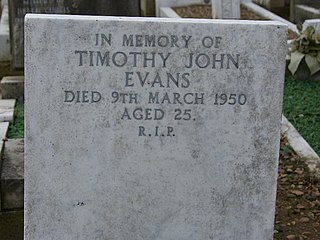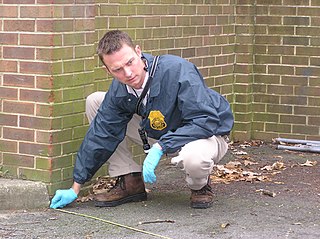Related Research Articles
Criminal psychology, also referred to as criminological psychology, is the study of the views, thoughts, intentions, actions and reactions of criminals and suspects. It is a subfield of criminology and applied psychology.

A miscarriage of justice occurs when an unfair outcome occurs in a criminal or civil proceeding, such as the conviction and punishment of a person for a crime they did not commit. Miscarriages are also known as wrongful convictions. Innocent people have sometimes ended up in prison for years before their conviction has eventually been overturned. They may be exonerated if new evidence comes to light or it is determined that the police or prosecutor committed some kind of misconduct at the original trial. In some jurisdictions this leads to the payment of compensation.
Gregg v. Georgia, Proffitt v. Florida, Jurek v. Texas, Woodson v. North Carolina, and Roberts v. Louisiana, 428 U.S. 153 (1976), is a landmark decision of the U.S. Supreme Court. It reaffirmed the Court's acceptance of the use of the death penalty in the United States, upholding, in particular, the death sentence imposed on Troy Leon Gregg. The set of cases is referred to by a leading scholar as the July 2 Cases, and elsewhere referred to by the lead case Gregg. The court set forth the two main features that capital sentencing procedures must employ in order to comply with the Eighth Amendment ban on "cruel and unusual punishments". The decision essentially ended the de facto moratorium on the death penalty imposed by the Court in its 1972 decision in Furman v. Georgia 408 U.S. 238 (1972). Justice Brennan dissent famously argued that "The calculated killing of a human being by the State involves, by its very nature, a denial of the executed person's humanity... An executed person has indeed 'lost the right to have rights."

The CSI effect describes the various ways in which the exaggerated portrayal of forensic science on crime television shows such as CSI: Crime Scene Investigation influences public perception. The term was first reported in a 2004 USA Today article describing the effect being made on trial jurors by television programs featuring forensic science.
The 1991 Austin yogurt shop killings are an unsolved quadruple homicide which took place at an I Can't Believe It's Yogurt! shop in Austin, Texas, United States on Friday, December 6, 1991. The victims were four teenage girls: 13-year-old Amy Ayers, 17-year-old Eliza Thomas, 17-year-old Jennifer Harbison and Jennifer's 15-year-old sister Sarah. Jennifer and Eliza were employees of the shop, while Sarah and her friend Amy were in the shop to get a ride home with Jennifer after it closed at 11:00 pm. Approximately one hour before closing time, a man who had tried to hustle customers in his queue was permitted to use the toilet in back, took a very long time and may have jammed a rear door open. A couple who left the shop just before 11:00 pm, when Jennifer locked the front door to prevent more customers entering, reported seeing two men at a table acting furtively.

Environmental criminology focuses on criminal patterns within particular built environments and analyzes the impacts of these external variables on people's cognitive behavior. It forms a part of criminology's Positivist School in that it applies the scientific method to examine the society that causes crime.
A false confession is an admission of guilt for a crime which the individual did not commit. Although such confessions seem counterintuitive, they can be made voluntarily, perhaps to protect a third party, or induced through coercive interrogation techniques. When some degree of coercion is involved, studies have found that subjects with highly sophisticated intelligence or manipulated by their so-called "friends" are more likely to make such confessions. Young people are particularly vulnerable to confessing, especially when stressed, tired, or traumatized, and have a significantly higher rate of false confessions than adults. Hundreds of innocent people have been convicted, imprisoned, and sometimes sentenced to death after confessing to crimes they did not commit—but years later, have been exonerated. It was not until several shocking false confession cases were publicized in the late 1980s, combined with the introduction of DNA evidence, that the extent of wrongful convictions began to emerge—and how often false confessions played a role in these.

Criminal investigation is an applied science that involves the study of facts that are then used to inform criminal trials. A complete criminal investigation can include searching, interviews, interrogations, evidence collection and preservation, and various methods of investigation. Modern-day criminal investigations commonly employ many modern scientific techniques known collectively as forensic science.
Quantitative methods provide the primary research methods for studying the distribution and causes of crime. Quantitative methods provide numerous ways to obtain data that are useful to many aspects of society. The use of quantitative methods such as survey research, field research, and evaluation research as well as others. The data can, and is often, used by criminologists and other social scientists in making causal statements about variables being researched.

The World's End Murders is the colloquial name given to the murder of two girls, Christine Eadie, 17, and Helen Scott, 17, in Edinburgh, in October 1977. The case is so named because both victims were last seen alive leaving The World's End pub in Edinburgh's Old Town. The only person to stand trial accused of the murders, Angus Robertson Sinclair, was acquitted in 2007 in controversial circumstances. Following the amendment of the law of double jeopardy, which would have prevented his retrial, Sinclair was retried in October 2014 and convicted of both murders on 14 November 2014. He was sentenced to life imprisonment with a minimum term of 37 years, the longest sentence by a Scottish court, meaning he would have been 106 years old when he was eligible for a potential release on parole. He died at HM Prison Glenochil aged 73 on 11 March 2019. Coincidentally, he died on the same day the BBC's Crimewatch Roadshow programme profiled the murders.
Computational criminology is an interdisciplinary field which uses computing science methods to formally define criminology concepts, improve our understanding of complex phenomena, and generate solutions for related problems.
Radical criminology states that society "functions" in terms of the general interests of the ruling class rather than "society as a whole" and that while the potential for conflict is always present, it is continually neutralised by the power of a ruling class. Radical criminology is related to critical and conflict criminology in its focus on class struggle and its basis in Marxism. Radical criminologists consider crime to be a tool used by the ruling class. Laws are put into place by the elite and are then used to serve their interests at the peril of the lower classes. These laws regulate opposition to the elite and keep them in power.

Criminology is the interdisciplinary study of crime and deviant behaviour. Criminology is a multidisciplinary field in both the behavioural and social sciences, which draws primarily upon the research of sociologists, political scientists, economists, legal sociologists, psychologists, philosophers, psychiatrists, social workers, biologists, social anthropologists, scholars of law and jurisprudence, as well as the processes that define administration of justice and the criminal justice system.
The Vicinage Clause is a provision in the Sixth Amendment to the United States Constitution regulating the vicinity from which a jury pool may be selected. The clause says that the accused shall be entitled to an "impartial jury of the State and district wherein the crime shall have been committed, which district shall have been previously ascertained by law". The Vicinage Clause limits the vicinity of criminal jury selection to both the state and the federal judicial district where the crime has been committed. This is distinct from the venue provision of Article Three of the United States Constitution, which regulates the location of the actual trial.
Maryland v. King, 569 U.S. 435 (2013), was a decision of the United States Supreme Court which held that a cheek swab of an arrestee's DNA is comparable to fingerprinting and therefore, a legal police booking procedure that is reasonable under the Fourth Amendment.
Marvin Charles Gabrion is an American murderer, rapist, and suspected serial killer convicted of the 1997 kidnapping and murder of 19-year-old Rachel Timmerman, of Cedar Springs, Michigan. Timmerman and her 11-month-old daughter, Shannon, disappeared two days before Gabrion was set to stand trial on rape charges filed by Rachel the previous summer. Rachel's body was found in Oxford Lake, weighted down by cinder blocks. Shannon remains missing, but is presumed deceased. Although Gabrion was not tried for killing Shannon, court documents describe her murder as “virtually undisputed.”

Population Zero is a 2016 found footage crime thriller film directed by Adam Levins that premiered at the Newport Beach International Film Festival on April 26, 2016.
Brian C. Kalt is an American legal scholar at the Michigan State University College of Law, particularly known for his research of the constitution of the United States.

The Zone of Death is the 50-square-mile (130 km2) area in the Idaho section of Yellowstone National Park in which, as a result of a reported loophole in the Constitution of the United States, a person may be able to theoretically avoid conviction for any major crime, up to and including murder.
Chris Clark is a British amateur crime writer who writes chiefly about serial killers and their supposed links to unsolved crimes. He is a retired police intelligence officer who worked in the King's Lynn area for Norfolk Police, although his career was somewhat unsuccessful and he had three applications to join the new National Criminal Intelligence Service rejected in 1993, with the commanding officers unimpressed by his record and applications. In 2022, his book Yorkshire Ripper: The Secret Murders, which was jointly written with journalist Tim Tate and alleged links between Peter Sutcliffe and unsolved murders, was made into an ITV prime-time documentary series of the same name.
References
- 1 2 Timmermans, Stefan (2007). Postmortem: How Medical Examiners Explain Suspicious Deaths. University of Chicago Press. p. 157. ISBN 978-0-226-80399-9.
- ↑ Adams, Charles F. (2005). Murder by the Bay: Historic Homicide in and about the City of San Francisco. Quill Driver Books. p. 162. ISBN 978-1-884995-46-0.
- ↑ "How to commit the perfect murder". Horizon. Season 2007. 2007-05-08.
- 1 2 3 Vedder, Clyde Bennett; Koenig, Samuel; Clark, Robert E. (1953). Criminology: A Book of Readings. Holt, Rinehart and Winston. p. 44.
Detectives have said that they have never seen a perfect crime. This is because the only perfect crimes are those in which no one even suspects...
- ↑ The Journal of Criminal Law, Criminology & Police Science. Vol. 53. Northwestern University School of Law. 1962. p. 141.
- ↑ Kalt, Brian (2005). "The Perfect Crime". Georgetown Law Journal. 93 (2): 77–79. SSRN 691642.
- ↑ Knudson, Thomas J. (August 30, 1987). "Bullfrog County, Nev., (Pop. 0) Fights Growth" . The New York Times.
- ↑ Hillinger, Charles (September 2, 1987). "Bullfrog, Nevada: Empty County to Croak Unless It Goes to Waste". Los Angeles Times.
- 1 2 Himmelreich, Claudia (2009-03-23). "Despite DNA Evidence, Twins Charged in Heist Go Free". Time. ISSN 0040-781X . Retrieved 2019-09-05.
- ↑ Doctor, Vikram (2013-02-22). "Story of unsolved opera house burglary in Mumbai, Rs 30-L heist amused everyone by its slick execution". The Economic Times. Retrieved 2021-09-19.
You could say it was the perfect crime